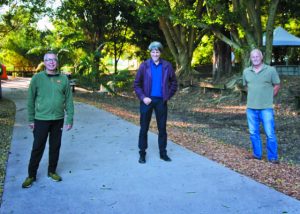Bird life with Tony Wellington
Spangled Drongos could be easily confused for male Koels. Both birds are black with red eyes and a metallic sheen on the back and wings. But the Drongo has metallic flecks on neck and chest – the “spangle” in the name. The best way to identify a Drongo is by its distinctive forked tail, a bit like a mermaid’s tail, which it flicks up and down.
This is a conspicuous, highly acrobatic bird, darting from a high perch to snatch insects in the air. The call is extremely varied, from a harsh chattering to distinctive notes like a wire being plucked. Drongos are also accomplished mimics andwill incorporate the calls of other birds into their song.
The word “drongo” has long been used in Australian vernacular as a synonym for fool. Perhaps the uninhibited, somewhat erratic behaviour of Drongos was the basis of their name becoming an insult? There was also an Australian racehorse in the 1920s that was named Drongo, presumably after the bird, and which never won any races. There are 26 species of Drongo in the world, but Australia only has the one.
Spangled Drongos exhibit strange migration patterns. Birds in northern Queensland do what is expected of southern hemisphere birds and fly north for winter. Birds in southern NSW, however, fly south during winter. And in the middle, where we are, they head east and west: to the coast for summer and back to the Great Dividing Range for winter.
Male and female Drongos are pretty much identical. They prefer wet forests but are also happy in mangroves and urban parks. Drongos are assertive birds and relatively tame aroundwe hominids.
Tony has worked as a filmmaker, artist, author, photographer and media lecturer. He has also been a Councilor on both the Sunshine Coast and Noosa Councils, as well as Mayor of Noosa.




